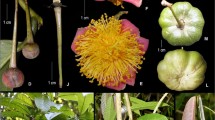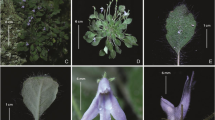Summary
Petrocosmea qiruniae M.Q.Han, Li Bing Zhang & Yan Liu (Gesneriaceae), a new species from Guizhou, China, is described and illustrated. It is most similar to P. leiandra (W.T.Wang) Z.J.Qiu in leaf blade shape and corolla type, especially in the colour of corolla throat and spots, indumentum of the stamens and the anther and ovary morphology. It was found on humid cliffs in an enormous limestone cave called the Qingxu Cave. In addition, Petrocosmea leiandra, based on P. martini H.Lév. var. leiandra W.T.Wang, originally published with very few descriptive data, is supplemented with more morphological data and a revised description.
Similar content being viewed by others
Avoid common mistakes on your manuscript.
Introduction
Previously, almost all species of Petrocosmea Oliv. were described solely from herbarium specimens which do not show the full range of the corolla coloration and obscure the indumentum of reproductive organs. Comprehensive field observations are therefore indispensable in the taxonomy of this genus.
During recent botanical field work in limestone areas of China in 2015, a plant of Petrocosmea from a limestone cave in Guizhou Province was collected. It was readily distinguished from the morphologically most similar species, P. leiandra (W.T.Wang) Z.J.Qiu, in having villous filaments. However, P. leiandra was poorly known because there were very few specimens available in herbaria and the original description was very simple. In 2016, however, we were fortunate to collect and observe P. leiandra from the type locality and establish more differences between the two species. After careful comparison of the material of the putative new species with the morphological characters of other species in the genus known in literature (Wang 1984, 1985; Burtt 1998; Li & Wang 2004; Wei & Wen 2009; Gou et al. 2010; Middleton & Triboun 2010; Zhao & Shui 2010; Shaw 2011; Xu et al. 2011; Qiu & Liu 2015; Qiu et al. 2011, 2012, 2015a, 2015b; Wang et al. 2013; Zhang et al. 2013), as well as studies on herbarium specimens in major herbaria (GXMI, IBK, KUN, PE), we conclude that our specimens represent a new species, which we describe and illustrate here.
Taxonomic Treatment
Petrocosmea qiruniae M.Q.Han, Li Bing Zhang & Yan Liu sp. nov. Type: China, Guizhou Province, Dafang County, Yangchang Town, Qingxu Cave, 1500 m, 27°5'54"N, 105°40'16"E, 27 May 2015, M. Q. Han & J. Q. Huang HMQ521 (holotype IBK!, isotypes IBK!, PE!).
http://www.ipni.org/urn:lsid:ipni.org:names:60478270-2
Perennial herbs, with short rhizomes and crowded fibrous roots. Leaves 10 – 15 per plant, all basal, petioles 2 – 5 cm long, pubescent; leaf blades ovate to widely ovate, 1 – 2 × 1 – 2.5 cm, herbaceous, bases cordate, margins serrate, apex obtuse to rounded, both surfaces puberulent to pubescent, lateral veins 2 – 4 on each side, adaxially impressed, abaxially conspicuous. Cymes 1 – 5, 1 – 2 flowers per cyme; peduncles 4 – 10 cm long, densely pubescent; bracteole 2, alternate; calyx 5-lobed nearly to base, lobes lanceolate, the adaxial three lobes shorter, c. 3 mm, the abaxial two lobes longer, c. 4 mm, puberulent outside, glabrous inside. Corolla light violet, puberulent outside, glabrous inside; tube c. 5 mm, 2 yellow spots inside the tube under the filaments, throat white; adaxial lips c. 3 mm, indistinctly 2-lobed, two lobes are fused nearly their entire length and each lobe is folded and rolled laterally to form a carinate-plicate shape of the adaxial lip that encloses the style, abaxial lips 7 – 9 mm long, 3-lobed to the middle, lobes widely ovate; stamens 2, c. 5 mm, adnate to the corolla tube at the base; filaments c. 3.5 mm, geniculate near the middle, densely transparent villous around the middle; anthers widely triangular, coherent, poricidal in apex, c. 1.5 mm long, dorsifixed, with brown capitate-glandular hairs on the dorsal side; staminodes 3, adnate to the corolla tube at the base, glabrous; pistil c. 9 mm; ovary lance-ovoid, c. 2 mm, with transparent pilose-glandular hairs and brown capitate-glandular hairs on the surface; style glabrous, c. 7 mm; stigma white. Capsules c. 6 mm, brown, long-ellipsoid, both loculicidally and septicidally dehiscent. Fig 1.
recognition. Morphologically, Petrocosmea qiruniae is most similar to P. leiandra, but differs in having a white corolla throat without any spots (vs violet with 2 white spots), corolla tube under the filaments with 2 yellow spots (vs 2 wine-red spots merging into one inside the corolla tube under the anthers), filaments villous (vs glabrous), anthers with brown capitate-glandular hairs at the dorsal side (vs glabrous), and ovary with pilose-glandular hairs and brown and transparent capitate-glandular hairs on the surface (vs transparent pilose-glandular hairs).
distribution. China, Guizhou Province, Dafang County.
specimens examined. china. Guizhou Province, Dafang County, Yangchang Town, Qingxu Cave, elev. 1500 m, 27°5’54 N, 105°40’16 E, 27 May 2015, M. Q. Han & J. Q. Huang HMQ520 (IBK!, PE!), HMQ521 (holotype IBK!, isotypes IBK!, PE!); HMQ522 (IBK!); 11 April 2016, M. Q. Han, Y. Dong & T. F. Lü HMQ970 (IBK!).
habitat. Petrocosmea qiruniae was observed to grow on moist shady cliffs in a limestone cave at an elevation of 1500 m.
conservation status. Petrocosmea qiruniae was only found from the type locality. The total number of individuals was approximately 200. Suitable habitats might be found in two inaccessible caves not far from the Qingxu Cave. Based on current information to date, the new species should be classified as ‘Data Deficient’ (DD) according to the IUCN Red List criteria (IUCN 2015) until more exploration has been carried out in neighbouring regions.
phenology. The new species has been collected in flower in May; its fruiting time is unknown.
etymology. The specific epithet commemorates Miss Qi-Run He, a friend of the first author. Her Chinese pinyin name "Qi-Run" means “incomparable fine jade” perfectly representing the characteristics of this new Petrocosmea.
vernacular name. Chinese mandarin: Qi run shi hu die (琦润石蝴蝶), which can be translated as "incomparable fine Petrocosmea".
notes. Morphologically, Petrocosmea qiruniae is similar to P. leiandra and a detailed morphological comparison of the two species is shown in Table 1.
Petrocosmea leiandra (W.T.Wang) Z.J.Qiu (Qiu & Liu 2015: 116). Type: China, Guizhou, Qingzhen City, Qinglong Mountain, 30 May 1936, S. W. Deng 90396 (holotype PE!, isotype A).
Perennial herbs, with short rhizomes and crowded fibrous roots. Leaves 8 – 15 per plant, all basal, petioles 2 – 5 cm long, pubescent; leaf blades ovate to elliptic, 1 – 2 × 1 – 2.5 cm, herbaceous, bases cordate, margins serrate, apex obtuse or rounded, both surfaces pubescent, lateral veins adaxially impressed, abaxially conspicuous, 2 – 3 on each side. Cymes 1 – 5, 1 flower per cyme; peduncles 4 –10 cm long, densely pubescent; bracteole 2, opposite; calyx 5-lobed nearly to base, lobes lanceolate, the adaxial three lobes shorter, c. 3 mm, the abaxial two lobes longer, c. 4 mm, pilose outside, glabrous inside. Corolla violet, pubescent outside, glabrous inside; tube c. 5 mm, two wine red spots merge into one inside the tube under the anthers, throat violet, 2 white spots on the throat; adaxial lip c. 3 mm, indistinctly 2-lobed, two lobes are fused nearly their entire length and each lobe is folded and rolled laterally to form a carinate–plicate shape of the adaxial lip that encloses the style, abaxial lip 7 – 9 mm, 3-lobed to the middle, lobes deltoid; stamens 2, c. 5 mm; adnate to the corolla tube at the base, filaments c. 3.5 mm, geniculate near the middle, glabrous; anthers ovate, coherent, poricidal, c. 1.5 mm long, glabrous, dorsifixed; staminodes 3, adnate to the corolla tube at the base, glabrous; pistil c. 9 mm; ovary lance-ovoid, c. 2 mm, with pilose-glandular hairs; style glabrous, c. 7 mm; stigma white. Capsules c. 6 mm, brown, long-ellipsoid, both loculicidally and septicidally dehiscent. Fig 2.
distribution. China, Guizhou Province, Qingzhen City.
specimen examined. china. Guizhou, Qingzhen City, Qinglong Mountain, 15 May. 1984, J. Q. Wu & J. H. Zhao 712 (PE); 11 April 2016, M. Q. Han, Y. Dong, & T. F. Lü HMQ968 (IBK!).
habitat. Petrocosmea leiandra was observed to grow in moist rocky crevices on a limestone hill at an elevation of 1300 m.
conservation status. Petrocosmea leiandra was only found in moist rocky crevices on a limestone hill, Qinglong Mountain, Qingzhen City, Guizhou. The total number of individuals was approximately 100. The habitat of P. leiandra has been threatened and damaged by tourism. Thus, we assess it to be Critically Endangered CR B1ab(iii) according to the IUCN red list criteria (IUCN 2015).
References
Burtt, B. L. (1998). A new species of Petrocosmea. The Gloxinian 1: 14 – 15.
Gou, G. Q., Wang, X. Y. & Xiong, Y. X. (2010). Petrocosmea xanthomaculata G. Q. Gou et A. Y. Wang a new species of the genus Petrocosmea Oliv. Bull. Bot. Res., Harbin 30: 394 – 396.
IUCN (2015). The IUCN Red List of Threatened Species, version 2015-3. IUCN Red List Unit, Cambridge U.K. Available from: http://www.iucnredlist.org/documents/RedListGuidelines.pdf.
Li, Z. Y. & Wang, Y. Z. (2004). Plants of Gesneriaceae in China, pp. 1 – 721. Henan Science and Technology Publishing House, Zhengzhou.
Middleton, D. J. & Triboun, P. (2010). Two new species of Petrocosmea (Gesneriaceae) from Thailand. Thai Forest Bull. (Bot.) 38: 42 – 47.
Qiu, Z. J., Li, C. Q. & Wang, Y. Z. (2015a). Petrocosmea glabristoma (Gesneriaceae), a New Species from Yunnan, China. Pl. Diversity Resources 37: 551 – 556.
Qiu, Z. J. & Liu, Z. Y. (2015). Plants of Petrocosmea in China. Science Press, Beijing.
Qiu, Z. J., Lu, Y. X., Li, C. Q., Dong, Y., Smith, J. F. & Wang, Y. Z. (2015b). Origin and evolution of Petrocosmea (Gesneriaceae) inferred from both DNA sequence and novel findings in morphology with a test of morphology-based hypotheses. BMC Pl. Biol. 15: 167.
Qiu, Z. J., Wang, X. L., Liu, Z. Y., Yang, J. F. & Zhang, S. Z. (2012). Cytological and phylogenetic study of Petrocosmea hexiensis (Gesneriaceae), a new species from Chongqing, China. Phytotaxa 74: 30 – 38.
Qiu, Z. J., Yuan, Z. L., Li, Z. Y. & Wang, Y. Z. (2011). Confirmation of a natural hybrid species in Petrocosmea (Gesneriaceae) based on molecular and morphological evidence. J. Syst. Evol. 49: 449 – 463.
Shaw, J. (2011). A new species of Petrocosmea. Plantsman 10: 177 – 179.
Wang, H. C., Zhang, L. B. & He, Z. R. (2013). Petrocosmea melanophthalma, a new species in section Deianthera (Gesneriaceae) from Yunnan, China. Novon 22: 486 – 490.
Wang, W. T. (1984). Notulae de Gesneriaceae sinensibus. Bull. Bot. Res., Harbin 4(1): 9 – 35.
Wang, W. T. (1985). The second revision of the genus Petrocosmea (Gesneriaceae). Acta Bot. Yunnan. 7: 49 – 68.
Wei, Y. G. & Wen, F. (2009). Petrocosmea xingyiensis (Gesneriaceae), a new species from Guizhou, China. Novon 19: 261 – 262.
Xu, W. B., Pan, B. & Liu, Y. (2011). Petrocosmea huanjiangensis, a new species of Gesneriaceae from limestone areas in Guangxi, China. Novon 21: 385 – 387.
Zhao, H. T. & Shui, Y. M. (2010). Petrocosmea shilinensis, a new species of Gesneriaceae from Yunnan, China. Acta Bot. Yunnan. 32: 328 – 330.
Zhang, Q., Pan, B., Meng, T., Li, G. F., Xu, W. B. & Li, Z. M. (2013). Petrocosmea funingensis (Gesneriaceae): a new species from southeastern Yunnan, China. Phytotaxa 77: 5 – 8.
Acknowledgements
The authors are grateful to Wei-Bin Xu, Yang Dong, Chao-Qun Li and Meng-Qing Han for their constructive suggestions and comments on the manuscript. Jin-Quan Huang assisted in the field work. This study was supported by the National Natural Science Foundation of China (Grant nos. 41161011 and 41661012).
Author information
Authors and Affiliations
Corresponding author
Additional information
Publisher’s Note
Springer Nature remains neutral with regard to jurisdictional claims in published maps and institutional affiliations.
Rights and permissions
About this article
Cite this article
Han, MQ., Yuan, Q., Lü, TF. et al. Petrocosmea qiruniae (Gesneriaceae), a new species from Guizhou, China with supplementary data and revised description of P. leiandra. Kew Bull 74, 22 (2019). https://doi.org/10.1007/s12225-019-9811-8
Accepted:
Published:
DOI: https://doi.org/10.1007/s12225-019-9811-8






